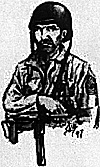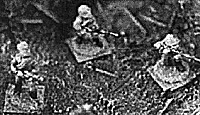 Fire power kills. This nasty little truism probably reared its
ugly head not long after you sent your squad tromping across an
open field against an MG 42 for the first time. Of course, you say
to yourself, "I had no choicer I had to do something or else I
would have never made it to the objective." But alas, letting your
squads go out and get themselves shredded by devastating
defensive fires also tends to make it difficult to reach one's
objective.
Fire power kills. This nasty little truism probably reared its
ugly head not long after you sent your squad tromping across an
open field against an MG 42 for the first time. Of course, you say
to yourself, "I had no choicer I had to do something or else I
would have never made it to the objective." But alas, letting your
squads go out and get themselves shredded by devastating
defensive fires also tends to make it difficult to reach one's
objective.
Now, I do not mean to denigrate the power of the defense. Dug in troops, bakced up by one or more machineguns are definitely a force to be reckoned witb, especially if you do not have tanks, mortars, or any other heavy support weapons available to "take out the nasty little cusses."
Lack of heavy weapons, however, does not provide you with an excuse for doing nothing, or worse, doing something dumb, like charging out into the open. Like Sean Connery said in the movie, The Rock, "Losers make excuses. The winner gets to take the prom queen home."
MG Squads
By the beginning of WW II, every major military power had squads that were built around a light machinegun or some sort of heavy, automatic weapon. Britain had its Bren, the US had the BAR, the Germans the famed MG 34, and the Russian, their DP. Even the Poles adopted the BAR and the Dutch the Lewis gun. How these weapons figures into each nation's squad tactics, of course, varied.
The Germans, for instance, centered their tactics at squad level around the organic machine-gun. The 'Landers' of the machine-gun Section were the squad's killers. Everyone else were there to support the killers.
The Americans, on the other hand, used their BAR as a support weapon. It was the task of the BAR gunner to supress the enemy while the squad leader, with the bulk of the squad, maneuvered to outflank the enemy and gain favorable ground from which they could force the enemy to give way.
While the relative merit of these two approaches can be debated, and around our small group, they are on a frequent basis, the simple truth is that both approaches demonstrate the importance of using fire power to establish a base of fire before launching any attack, no matter how minor. Erwin Rommel, in his early years as the commander of assault troops, knew this. In his book, Infantry Attacks, he advocated attacking only when you had established an effective base of fire. In Italy, he would use his troops in a ratio of upto l2-1 in the number of troops employed to provide supporting fire venus the number of men actually sent forward to conduct the assault. As a tactical force operations officer, I used the same principles when planning for and conducting offensive operations at Fort Hood, Texas and the Nation Training Center at Fort Irwin, California And guess what? Rommel's solution to the problem of overcoming defensive fire, first used by him in The Great War, still works.
 Application
Application
For you, the gamer using Battleground rules, application of this tried and true technique is simple. First, you must decide, as quickly as possible, where you are going to make your main effort. This is important. It is against this point in the enemy's zone, or on the gaming table, where all of your efforts will be focused. If possible, it should be a weak point in your opponent's zone.
If there is no apparent weak point, then you must select a place where your attacking force can approach under the security of cover and concealment, safe from direct enemy fire, for as long as possible. When you are ready, you must then use everything you can to force a hole in the enemy lines. You must also select a point that can be brought under fire by automatic weapons, both those organic to your squad and attached to it. In the case of an American infantry platoon, this would be a Cal 30 from the platoon's weapons squad or even a Cal .5O machinegun from the company's weapons platoon.
Once you have determined where you are going to make your 'break in', you must take your time and move your supporting elements forward, into good firing positions. These should be locations where the supporting weapons can pass fire on known or likely enemy machine-gun positions throughout the attack by the maneuver element. Ideally, the best places to site supporting weapons are to either side of your planned axis of attack. After all, there is nothing worse than having your own troops move forward and, in the process, mask the machine-guns you placed to support their attack.
Once you have your supporting weapons in place, you have a couple of options. First, you can hold your fire, send your troops out, into the open, and wait for the enemy to fire on them and reveal their positions. This tactic is, quite natural, rough on the maneuver force, and pre-supposes that the enemy will go that turn before your supporting weapons do. If however, the card or chit for your supporting weapons is drawn before that of the enemy machine-gun, then the sacrifice of your infantry will have been in vain.
A second option is to place your supporting weapons on "OP Fire". In this case, regardless of card or chit play, your supporting weapons will be able, if you placed them correctly, to fire on the enemy after he has fired on his first action, but before he has the chance to take his second action. While your infantry will still, in all likelihood, suck up a few casualties, at least you are assured that you will be able to take a whack at you opponent.
A third option is to fire blindly at known or suspected enemy locations. Also known as recon by fire, this method is, quite literally, a shot in the dark. But, it can produce effects, provided your favorite Deity smiles down upon your die rolls. Of course, if the enemy positions are known to you, then, by all means, hammer them until you kill or scatter your opponent before you like so many dead, autumn leaves.
To cover your preparation, and confuse the enemy as to the exact locadon of your intended 'break in', it will be necessary to conduct supporting attacks or demonstrations. These attacks can be simple demonstrations consisting of part of your force parading about where your opponent can see them, but is unable to bring effective fire upon them. You can also use fire to deceive your enemy as to where your main effort will be. Ideally, you will be in a position to do both. By using demonstrations, you will force your opponent to keep his forces thinly spread, allowing you an opportunity to mass the bulk of your combat power against the single, decisive point that you selected. Forces used as part of the demonstrations do not have to be wasted. They can provide the reserve or follow up forces used in the exploitation of your breakthrough elsewhere. While such a role may not be as glamorous as that given to the assault force, just think, you may be the one who gets to take the prom queen home.
The key to all of this, as in any military operation, is a bit of forethought and a little planning. While it is true most plans do not play out as originally envisioned, either on the gaming table or in real life, a plan does provide you with a scheme of maneuver that pennits all the elements on your side to effectively coordinate and orchestrate their efforts toward a single, well defined goal.
A key portion of that must be fire support. In the Army, under the 'Execution' paragraph of an operations orders, there is one sub para for maneuver, and one, equally important sub para for fire support. Players who stumble onto the gaming table without taking the time to plan or coordinate their efforts with their fellow war gamers will, and normally do, play the price.
So, good hunting, have fun, and may the Dice be with you!
Back to Battle-Wire vol. 2 issue 1 Table of Contents
Back to Battle-Wire List of Issues
Back to MagWeb Master Magazine List
© Copyright 1998 by Easy Eight Enterprises, Inc.
This article appears in MagWeb (Magazine Web) on the Internet World Wide Web. Other military history articles and gaming articles are available at http://www.magweb.com